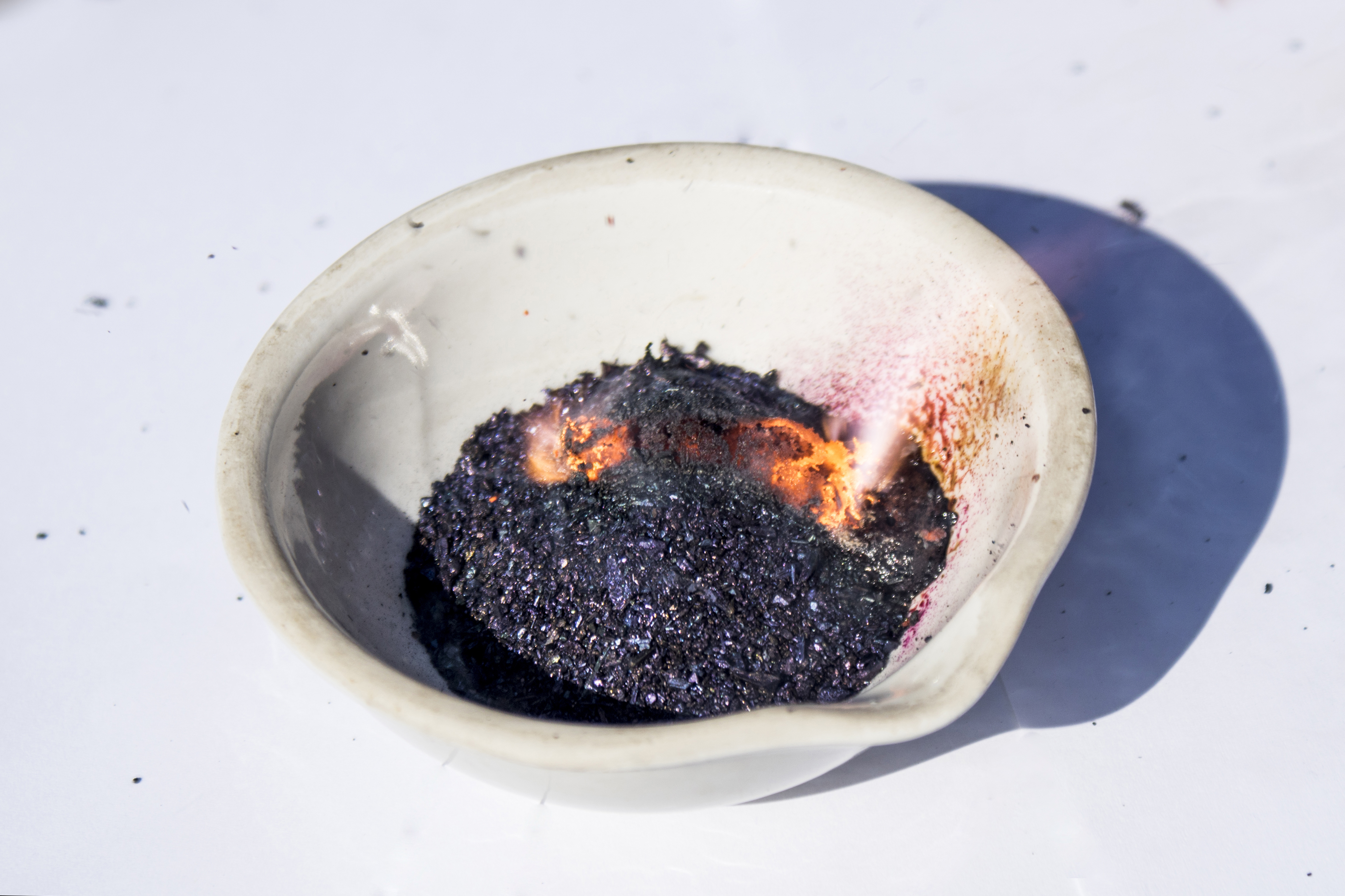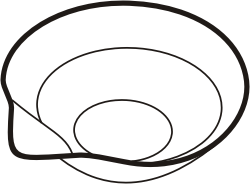|
Chemical Volcano
The chemical redox reaction between potassium permanganate and glycerol is often used to demonstrate the powerful oxidizing property of potassium permanganate, especially in the presence of organic compounds such as glycerol. The exothermic (heat producing) reaction between potassium permanganate (KMnO4), a strong oxidizing agent, and glycerol (C3H5(OH)3), a readily oxidised organic substance, is an example of an experiment sometimes referred to as a "chemical volcano". Explanation Potassium permanganate (KMnO4) is a dark violet colored powder. Its reaction with glycerol (commonly known as glycerin or glycerine) (C3H5(OH)3) is highly exothermic, resulting rapidly in a flame, along with the formation of carbon dioxide and water vapor: 14KMnO4(s) + 4C3H5(OH)3(l) → 7K2CO3(s) + 7Mn2O3(s) + 5CO2(g) + 16H2O(g). Crystalline potassium permanganate (KMnO4) is placed in an evaporating dish. A depression is made at the center of the permanganate powder and glycerol liquid is added ... [...More Info...] [...Related Items...] OR: [Wikipedia] [Google] [Baidu] |
KMnO4 And Glycerol
Potassium permanganate is an inorganic compound with the chemical formula KMnO4. It is a purplish-black crystalline salt, that dissolves in water as K+ and , an intensely pink to purple solution. Potassium permanganate is widely used in the chemical industry and laboratories as a strong oxidizing agent, and also as a medication for dermatitis, for cleaning wounds, and general disinfection. It is on the World Health Organization's List of Essential Medicines. In 2000, worldwide production was estimated at 30,000 tonnes. Properties Potassium permanganate is the potassium salt of the tetrahedral transition metal oxo complex permanganate, in which four O2- ligands are bound to a manganese(VII) center. Structure KMnO4 forms orthorhombic crystals with constants: ''a'' = 910.5 pm, ''b'' = 572.0 pm, ''c'' = 742.5 pm. The overall motif is similar to that for barium sulfate, with which it forms solid solutions. In the solid (as in solution), each MnO4− cent ... [...More Info...] [...Related Items...] OR: [Wikipedia] [Google] [Baidu] |
Crystalline
A crystal or crystalline solid is a solid material whose constituents (such as atoms, molecules, or ions) are arranged in a highly ordered microscopic structure, forming a crystal lattice that extends in all directions. In addition, macroscopic single crystals are usually identifiable by their geometrical shape, consisting of flat faces with specific, characteristic orientations. The scientific study of crystals and crystal formation is known as crystallography. The process of crystal formation via mechanisms of crystal growth is called crystallization or solidification. The word ''crystal'' derives from the Ancient Greek word (), meaning both "ice" and "rock crystal", from (), "icy cold, frost". Examples of large crystals include snowflakes, diamonds, and table salt. Most inorganic solids are not crystals but polycrystals, i.e. many microscopic crystals fused together into a single solid. Polycrystals include most metals, rocks, ceramics, and ice. A third category of s ... [...More Info...] [...Related Items...] OR: [Wikipedia] [Google] [Baidu] |
Sugar Snake
"Black snake" is a term that can refer to two similar types of firework, the Pharaoh's snake and the sugar snake. The "Pharaoh's snake" or "Pharaoh's serpent" is the original version of the black snake experiment. It produces a more impressive snake, but its execution depends upon mercury (II) thiocyanate, which is no longer in common use due to its toxicity. For a "sugar snake", sodium bicarbonate and sugar are the commonly used chemicals. Once lit, both fireworks emit smoke and spew out ash resembling a snake via an intumescent reaction. They remain on the ground and emit no sparks, flares, projectiles, or sound. Pharaoh's snake The Pharaoh's snake is a more dramatic experiment, yet it requires more safety precautions than the sugar snake due to the presence of toxic mercury vapor and other mercury compounds. History This reaction was discovered by Wöhler in 1821, soon after the first synthesis of mercury thiocyanate. It was described as "winding out from itself a ... [...More Info...] [...Related Items...] OR: [Wikipedia] [Google] [Baidu] |
Carbon Snake
Carbon snake is a demonstration of the dehydration reaction of sugar by concentrated sulfuric acid. With concentrated sulfuric acid, granulated table sugar ( sucrose) performs a degradation reaction which changes its form to a black solid-liquid mixture. The carbon snake experiment can sometimes be misidentified as the black snake, "sugar snake", or "burning sugar" reaction, all of which involve baking soda rather than sulfuric acid. Explanation Concentrated sulfuric acid can perform a dehydration reaction with table sugar. After mixing, the color changes from white to brownish and eventually to black. The expansion of the mixture is the result of vaporization of water and CO2 inside the container. The gases inflate the mixture to form a snake-like shape, and give off a burned sugar smell. The granularity of the sugar can greatly affect the reaction: powdered sugar reacts very quickly but sugar cubes take longer to react. When sucrose is dehydrated, heat is given out to t ... [...More Info...] [...Related Items...] OR: [Wikipedia] [Google] [Baidu] |
Excited State
In quantum mechanics, an excited state of a system (such as an atom, molecule or nucleus) is any quantum state of the system that has a higher energy than the ground state (that is, more energy than the absolute minimum). Excitation refers to an increase in energy level above a chosen starting point, usually the ground state, but sometimes an already excited state. The temperature of a group of particles is indicative of the level of excitation (with the notable exception of systems that exhibit negative temperature). The lifetime of a system in an excited state is usually short: spontaneous or induced emission of a quantum of energy (such as a photon or a phonon) usually occurs shortly after the system is promoted to the excited state, returning the system to a state with lower energy (a less excited state or the ground state). This return to a lower energy level is often loosely described as decay and is the inverse of excitation. Long-lived excited states are often called ... [...More Info...] [...Related Items...] OR: [Wikipedia] [Google] [Baidu] |
Energy Level
A quantum mechanical system or particle that is bound—that is, confined spatially—can only take on certain discrete values of energy, called energy levels. This contrasts with classical particles, which can have any amount of energy. The term is commonly used for the energy levels of the electrons in atoms, ions, or molecules, which are bound by the electric field of the nucleus, but can also refer to energy levels of nuclei or vibrational or rotational energy levels in molecules. The energy spectrum of a system with such discrete energy levels is said to be quantized. In chemistry and atomic physics, an electron shell, or principal energy level, may be thought of as the orbit of one or more electrons around an atom's nucleus. The closest shell to the nucleus is called the " shell" (also called "K shell"), followed by the " shell" (or "L shell"), then the " shell" (or "M shell"), and so on farther and farther from the nucleus. The shells correspond with the principal quan ... [...More Info...] [...Related Items...] OR: [Wikipedia] [Google] [Baidu] |
Electron
The electron ( or ) is a subatomic particle with a negative one elementary electric charge. Electrons belong to the first generation of the lepton particle family, and are generally thought to be elementary particles because they have no known components or substructure. The electron's mass is approximately 1/1836 that of the proton. Quantum mechanical properties of the electron include an intrinsic angular momentum ( spin) of a half-integer value, expressed in units of the reduced Planck constant, . Being fermions, no two electrons can occupy the same quantum state, in accordance with the Pauli exclusion principle. Like all elementary particles, electrons exhibit properties of both particles and waves: They can collide with other particles and can be diffracted like light. The wave properties of electrons are easier to observe with experiments than those of other particles like neutrons and protons because electrons have a lower mass and hence a longer de Broglie wavele ... [...More Info...] [...Related Items...] OR: [Wikipedia] [Google] [Baidu] |
Pink (colour)
Pink is the color of a namesake flower that is a pale tint of red. It was first used as a color name in the late 17th century. According to surveys in Europe and the United States, pink is the color most often associated with charm, politeness, sensitivity, tenderness, sweetness, childhood, femininity, and romance. A combination of pink and white is associated with chastity and innocence, whereas a combination of pink and black links to eroticism and seduction. In the 21st century, pink is seen as a symbol of femininity, though this has not always been true; in the 1920s, pink was seen as a color that reflected masculinity. In nature and culture File:Color icon pink v2.svg, Various shades of pink File:Dianthus.jpg, The color pink takes its name from the flowers called pinks, members of the genus ''Dianthus''. File:Rosa Queen Elizabeth1ZIXIETTE.jpg, In most European languages, pink is called ''rose'' or ''rosa'', after the rose flower. File:Cherry blossoms in the Tsu ... [...More Info...] [...Related Items...] OR: [Wikipedia] [Google] [Baidu] |
Lilac (colour)
Lilac is a color that is a pale violet (color), violet tone representing the average color of most lilac flowers. The colors of some lilac flowers may be equivalent to the colors shown below as ''pale lilac'', ''rich lilac'', or ''deep lilac''. However, there are other lilac flowers that are colored red-violet. The first recorded use of ''lilac'' as an English language, English color name was in 1775. The color "lilac" has an eponymous book published in 2018 by Coloratura Publisher. Variations Pale lilac Pale lilac is the color represented as ''lilac'' in the ISCC–NBS system, ISCC-NBS color list. The source of this color is sample 209 in the ISCC-NBS Dictionary of Color Names (1955). Bright lilac The color bright lilac (displayed on the right) is the color labeled ''lilac'' by Crayola in 1994 as one of the colors in its List of Crayola crayon colors#Magic Scent, Magic Scent specialty box of colors. Rich lilac Rich lilac, a rich tone of lilac labeled ''lilac ... [...More Info...] [...Related Items...] OR: [Wikipedia] [Google] [Baidu] |
Evaporating Dish
An evaporating dish is a piece of laboratory glassware used for the evaporation of solutions and Precipitation (chemistry), supernatant liquids, and sometimes to their melting point. Evaporating dishes are used to evaporate excess solvents – most commonly water – to produce a concentrated solution or a solid precipitate of the dissolved substance. Most are made of porcelain or borosilicate glass. Shallow glass evaporating dishes are commonly termed "watch glasses", since they resemble the front window of a pocket watch. Some used for high-temperature work are of refractory metals, usually of platinum, owing to its non-reactive behaviour and low risk of contamination. The capacity of evaporators is usually small – in the range 3–10 Millilitre, ml. Larger dishes, up to 100 ml, are different in shape, and are more hemispherical. The evaporator is used most often in Quantitative analysis (chemistry), quantitative analysis. In the determination of silicon content i ... [...More Info...] [...Related Items...] OR: [Wikipedia] [Google] [Baidu] |
Water Vapor
(99.9839 °C) , - , Boiling point , , - , specific gas constant , 461.5 J/( kg·K) , - , Heat of vaporization , 2.27 MJ/kg , - , Heat capacity , 1.864 kJ/(kg·K) Water vapor, water vapour or aqueous vapor is the gaseous phase of water. It is one state of water within the hydrosphere. Water vapor can be produced from the evaporation or boiling of liquid water or from the sublimation of ice. Water vapor is transparent, like most constituents of the atmosphere. Under typical atmospheric conditions, water vapor is continuously generated by evaporation and removed by condensation. It is less dense than most of the other constituents of air and triggers convection currents that can lead to clouds. Being a component of Earth's hydrosphere and hydrologic cycle, it is particularly abundant in Earth's atmosphere, where it acts as a greenhouse gas and warming feedback, contributing more to total greenhouse effect than non-condensable gases such as carbon dioxide an ... [...More Info...] [...Related Items...] OR: [Wikipedia] [Google] [Baidu] |
Redox
Redox (reduction–oxidation, , ) is a type of chemical reaction in which the oxidation states of substrate (chemistry), substrate change. Oxidation is the loss of Electron, electrons or an increase in the oxidation state, while reduction is the gain of electrons or a decrease in the oxidation state. There are two classes of redox reactions: * ''Electron-transfer'' – Only one (usually) electron flows from the reducing agent to the oxidant. This type of redox reaction is often discussed in terms of redox couples and electrode potentials. * ''Atom transfer'' – An atom transfers from one substrate to another. For example, in the rusting of iron, the oxidation state of iron atoms increases as the iron converts to an oxide, and simultaneously the oxidation state of oxygen decreases as it accepts electrons released by the iron. Although oxidation reactions are commonly associated with the formation of oxides, other chemical species can serve the same function. In hydrogen ... [...More Info...] [...Related Items...] OR: [Wikipedia] [Google] [Baidu] |










